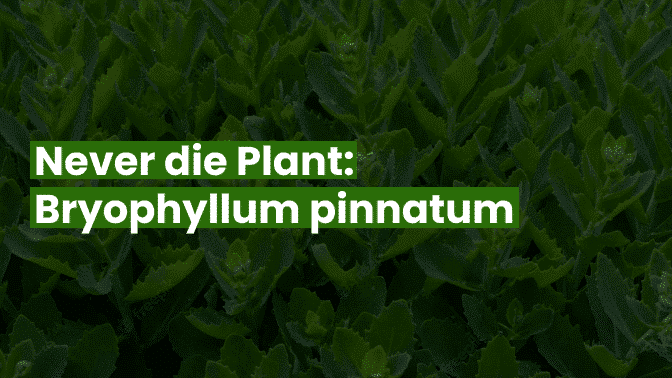The “never die” plant, also known as Bryophyllum pinnatum, is a succulent plant that is native to Madagascar, but can now be found in many tropical regions around the world. This remarkable plant has earned its nickname because of its ability to produce new plants from its leaves, even when they are detached from the main plant. This unique feature has made it a popular addition to many households and gardens.
Bryophyllum pinnatum belongs to the Crassulaceae family, which also includes other popular succulent plants like the jade plant and the string of pearls. The plant is also known by other common names like “life plant,” “air plant,” and “goethe plant.”
The “never die” plant is a relatively small plant, growing up to around 1 meter in height. It has fleshy, oval-shaped leaves that grow in opposite pairs along the stem. The leaves are green and often have small plantlets growing along the edges. When these plantlets drop off the main plant and land on soil, they can quickly take root and grow into new plants.
Bryophyllum pinnatum is a low-maintenance plant that is easy to care for. It thrives in bright, indirect sunlight and can tolerate a range of temperatures, making it a popular choice for indoor and outdoor gardens. The plant prefers well-draining soil and should be watered regularly, but not too frequently, as overwatering can lead to root rot.
In addition to its medicinal properties, the “never die” plant has also been used in agriculture as a natural insecticide. The plant contains compounds that repel a variety of pests like aphids and whiteflies, making it a natural alternative to chemical pesticides.
Read Also: Pegan diet food list: Everything you need to know
Health benefits list them
Bryophyllum pinnatum, also known as the “never die” plant, is known for its medicinal properties and has been used in traditional medicine for various ailments. Here are some potential health benefits associated with Bryophyllum pinnatum:
- Anti-inflammatory properties: Bryophyllum pinnatum has been found to possess anti-inflammatory properties that can help reduce swelling and inflammation. This property is useful in treating conditions such as arthritis, gout, and other inflammatory conditions.
- Wound healing: The plant has been traditionally used to treat wounds and burns. The leaves of the plant contain compounds that have anti-inflammatory and anti-bacterial properties, which may help promote wound healing and prevent infections.
- Antimicrobial properties: Bryophyllum pinnatum has been found to have antimicrobial properties that can help fight against harmful microorganisms such as bacteria, viruses, and fungi. These properties can help in treating a wide range of infections.
- Respiratory problems: The plant has been traditionally used to treat respiratory problems such as coughs, bronchitis, and asthma. It contains compounds that can help relax the smooth muscles in the airways, which may help relieve breathing difficulties.
- Digestive problems: Bryophyllum pinnatum has been used to treat digestive problems such as constipation, diarrhoea, and indigestion. It contains compounds that can help stimulate digestion and promote bowel movements.
- Cardiovascular health: Some studies have suggested that the plant may have cardiovascular benefits such as reducing blood pressure and cholesterol levels. These properties may help reduce the risk of heart disease and stroke.
- Antioxidant properties: Bryophyllum pinnatum has been found to possess antioxidant properties, which can help protect the body against damage from free radicals. Free radicals are harmful molecules that can contribute to the development of various diseases.
- Diabetes: The plant has been traditionally used to treat diabetes. It contains compounds that can help regulate blood sugar levels, which may be beneficial for people with diabetes.
It’s worth noting that while there is some evidence to support these potential health benefits, further research is needed to fully understand the plant’s medicinal properties and to confirm its efficacy in treating specific health conditions. As with any herbal remedy, it’s important to consult a healthcare professional before using Bryophyllum pinnatum as a treatment.
Possible downsides
While Bryophyllum pinnatum has been traditionally used for its medicinal properties, there are also some potential downsides to be aware of:
- Toxicity: The plant contains toxic compounds called bufadienolides, which can be harmful if ingested in large amounts. Ingesting the plant can cause vomiting, diarrhoea, and other gastrointestinal problems, and in severe cases, it can lead to cardiac arrest.
- Pregnancy and breast-feeding: The plant should be avoided by pregnant and breastfeeding women, as it may cause contractions in the uterus and affect the health of the developing fetus or newborn.
- Interactions with medications: Bryophyllum pinnatum may interact with certain medications, such as blood pressure medications, heart medications, and diabetes medications. If you are taking any medications, it’s important to speak with your healthcare provider before using this plant.
- Skin irritation: The plant’s sap can cause skin irritation and may lead to rashes or allergic reactions in some people.
- Lack of research: While the plant has been used for medicinal purposes for many years, there is still limited scientific research available to support its efficacy and safety. More research is needed to fully understand the plant’s potential benefits and risks.
In summary, while Bryophyllum pinnatum may offer some potential health benefits, it’s important to use it with caution and under the guidance of a healthcare professional. Pregnant and breastfeeding women, individuals taking medications, and those with sensitive skin should exercise extra caution when using the plant.
Conclusion
the “never die” plant, or Bryophyllum pinnatum, is a remarkable succulent that has earned its nickname because of its ability to produce new plants from its leaves. This unique feature has made it a popular addition to many households and gardens.
The plant is easy to care for and has a number of potential medicinal and agricultural uses. Whether you are a seasoned gardener or a beginner, the “never die” plant is a fascinating and rewarding plant to care for.
[bwla_faq single=”1″ fpid=”35716″/]


